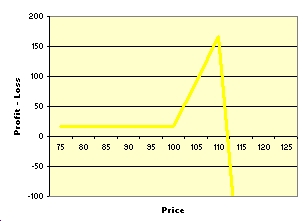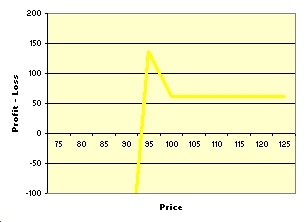Options Frontspreads Explained
Marcus Holland | Mar 14, 2013 02:00AM ET
In a previous article options backspreads, which benefit from volatile trading conditions, were explained in more depth. Today’s discussion is about its counterpart, the options frontspread.
A frontspread is an options trading strategy which benefits from a lack of volatility in market conditions. It consists of selling x number of options and simultaneously buying a smaller number of further OTM options.
Where an options backspread needs the price of the underlying asset to move to one or the other side, a frontspread will profit if the price remains stagnant or remains within a fairly limited price range.
The call front spread or call ratio spread
This is a strategy to put on where the trader is fairly sure that the market will not rally strongly during the contract term of the option. The position makes money if the price of the underlying goes down, if it remains the same and even if it goes up to a certain extent. The only way a call front spread can lose money is if the price of the underlying asset moves beyond the strike price of the short options.
A call front spread is set up by:
a) Buying a certain number of ATM call options and
b) Simultaneously selling more OTM call options
How many call options are bought and how many sold are determined by how far OTM the trader wants the short options to be. The further OTM these are, the less premium they bring in and hence fewer call options can be bought unless one sells more OTM calls.
Fig. 9.24(a) below illustrates a typical call front spread.

In this example 15 ATM call options were bought and 100 sold.
The put front spread or put ratio spread
This is to a large extent very similar to a call front spread, except that in this case put options are used instead of call options. As with the call front spread, this strategy will make a profit in 3 directions: it will be profitable if the price goes up, remains stagnant or even if it goes down to a certain degree.
This ability of a front spread of course greatly enhances the probability that the trade will end in a profit.
Fig. 9.24(b) below illustrates a typical put front spread / put ratio spread

In this particular example, 15 ATM put options were bought and one hundred and 95 put options were sold simultaneously.
Maximum profit potential
Both the call front spread and the put front spread above reach their maximum profit potential if the price of the underlying asset closes exactly at the strike price of the short options.
In the case of Fig. 9.24(a) that would be 110 and in the case of Fig. 9.24(b) it would be 95. After that the ‘uncovered’ call or put option starts to drag down the profit level until the position goes into a loss.
The profit at the maximum level can be calculated using the following formula:
a) (Strike price of short Options – strike price of long options) x number of long options plus
b) Net credit derived from initially setting up the trade.
Original post
Trading in financial instruments and/or cryptocurrencies involves high risks including the risk of losing some, or all, of your investment amount, and may not be suitable for all investors. Prices of cryptocurrencies are extremely volatile and may be affected by external factors such as financial, regulatory or political events. Trading on margin increases the financial risks.
Before deciding to trade in financial instrument or cryptocurrencies you should be fully informed of the risks and costs associated with trading the financial markets, carefully consider your investment objectives, level of experience, and risk appetite, and seek professional advice where needed.
Fusion Media would like to remind you that the data contained in this website is not necessarily real-time nor accurate. The data and prices on the website are not necessarily provided by any market or exchange, but may be provided by market makers, and so prices may not be accurate and may differ from the actual price at any given market, meaning prices are indicative and not appropriate for trading purposes. Fusion Media and any provider of the data contained in this website will not accept liability for any loss or damage as a result of your trading, or your reliance on the information contained within this website.
It is prohibited to use, store, reproduce, display, modify, transmit or distribute the data contained in this website without the explicit prior written permission of Fusion Media and/or the data provider. All intellectual property rights are reserved by the providers and/or the exchange providing the data contained in this website.
Fusion Media may be compensated by the advertisers that appear on the website, based on your interaction with the advertisements or advertisers.